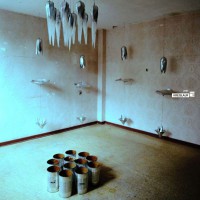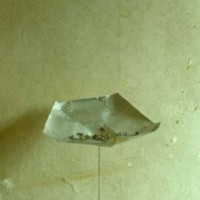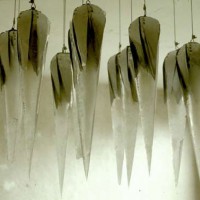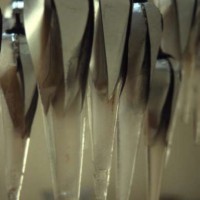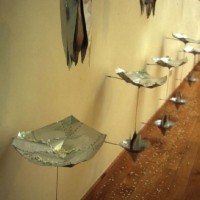Kreislauf
Materials:
Reclaimed aluminium printing press plates, graded stones, rivets, aluminium cable, water, reclaimed aluminium cans and bicycle innertube rubber.
Concept:
The title of this exhibition ‘Kreislauf ’ is the German word for circulation. The installation presents a narrative – the cycle of growth, decomposition and re-growth. Working with ice, stones and recycled aluminium from drink cans and printing press plates, one enters a fantastic sci-fi garden, a space with an organic sense of timing controlled by gravity and temperature, a reminder of a slower natural rhythm.
Kreislauf raises a dialogue about humans’ attempts to replicate nature, their detachment from and role within the natural world. Working at a grass roots level the artist re-assesses the way we value waste by creating an environment resembling a post-apocalyptic garden filled with hybrid species alluding to cycles of consumption, deterioration and re-growth, a space where science has failed in its attempt to replicate nature. The installation communicates with sound and motion, harnessing the energy in the gallery to produce motion and change within the sculptural environment. ‘Music has an effect on snakes, not by means of the mental ideas it induces in them but because snakes are elongated, coil up languorously on the ground and touch the earth almost along the entire length of their bodies; thus the musical vibrations transmitted to earth affect these bodies as a very subtle and very long massage; well, I propose to treat the public like snakes.’6
A video documentary describes the work as follows: ‘Twelve sculptures dripping a rapid irregular rhythm. High pitched and loud amplified by the steel cans, as the water level rises the reverberation grows deeper, the resonance lower. In the morning the sun shines crisp and bright, time passes away. The metal glistens with condensation.
As the day grows longer the sound reflects the softer light, the dripping is muffled a little as the drops now fall into pools of water. As the ice stalactites grow smaller, suddenly a spear of ice crashes down into the pool below. Gravity is at work all day. The forms around the walls have their own sense of timing. They drip slowly and passively in the morning, the aluminium shell insulating the ice inside.
By midday the first stones fall with a crash onto the plate below, which acts as a drum pad. Occasionally clusters of small pebbles fall all at once, some bouncing out onto the floor. Larger stones land with a thud. Stones like hybrid seeds collect on the aluminium plates.
By the late afternoon these forms take the focus as the centre pods hang empty over the still pools of water. At an even slower, stiller pace, the silent forms at the bottom of each of the wall pieces gradually open into full bloom. The rhythm ceases. The moons’ glow illuminates the empty metal pods.’
The larger research surrounding ‘Kreislauf ’ was an investigation of ‘rubbish’. Flanagan’s interest in rubbish was at the compost heap end of the garbage chain – the way nature recycles and the way man can interrupt the natural cycle through use of non-biodegradable materials. The rubbish we produce enters a cycle of discard, decomposition, re-growth, reuse. The use of hybrid seeds in farming also effects natural diversity, hybrid seeds will not germinate, and their dominance in commercial agriculture means hundreds of smaller species have become extinct. ‘Kreislauf ’ portraits human desire to control nature, an attempt to replicate it and to replace it, but reminds us to respect this process and find ways to live in harmony with it – we are a part of a natural cycle and will ultimately be returned to the soil.
Project Partners:
Matthias Klaß – experiment BAW Kassel, Germany;
Werner Bidlingmaier, School of Architecture and Civil Engineering – Bauhaus University Weimar; Germany;
Liz Bachhuber, Faculty of Gestaltung – Bauhaus University Weimar, Germany.
Exhibitions:
Rundgang, Straßenbahn Depo, Weimar 2001
Täglich Meer – Spätschicht am Kunstbau, Atelier-Halle von Ulrich Samper, E.-Thälmannstr. 20, Weimar, Germany, 2001.
Flotsam and Jetsam concerning art and refuse and refuse and art, Documenta Halle, Kassel, Germany 2001.
Regular Return, Dunamaise Centre for the Arts, Portlaoise, Ireland, 2002.
Flotsam and Jetsam concerning art and refuse and refuse and art, Kunsthaus Berthanian Berlin, 2003.
Publications:
PFÜTZE, H. (2003) Flotsam and Jetsam on Art and Refuse and Art with Refuse. Kunstforum International Das Magische II, No. 164. Pp. 280 – 2.
MÜLLER, K. B. & SUHR, C. (2003) Abfallaufwertung. Tip Berlin Magazin. Nr. 04/03, 13 – 26 Feb 2003. P. 78.
O’DOMHNAILL, S. (2002) Sculpture Exhibition at the Dunamaise. The Laois Nationalist. 30th Jul ed. Ireland. P. 9.
O’LOUGHLIN, D. (2002) Dunamaise Return for Australian Artists. The Leinster Express. 27th Jul. ed. Portlaoise, Ireland. P. 9.
BACHHUBER, P. L. & BIDLINGMAIER, P. W. (2001) Flotsam and Jetsam – Ballast and Treibgut, On Art and Refuse and Art With Refuse, Weimar, Germany, University Publishers, Bauhaus University Weimar. Pp. 28, 31, 86-87, 94 – 97, 112.
Thanks:
Liz Bachhuber
Nina Lündstrom
Kai Kehmann
Jörg Schribber.
Endnotes:
6. Antonin Artaud “Le theâtre et son double”(1938) sited in Denis Hollier, “The Death of Paper Part Two – Artaud’s Sound Systems” October 80, Spring 1997. Pp. 27 – 37.
